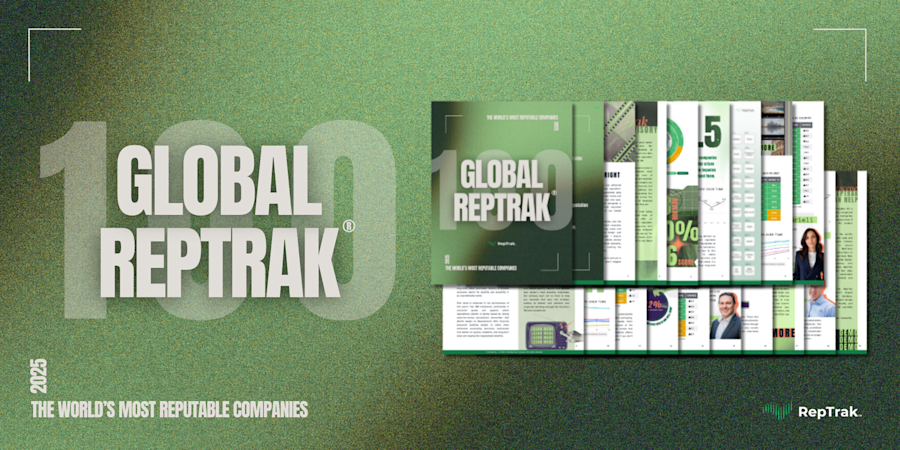6 Key Steps that Will Help Your Company Respond to Any Crisis Situation
Blog Post22 Jun, 2020
“The world is out of balance.”
That’s how Kasper Nielsen, co-founder and Chief Strategy Officer at The RepTrak Company, began a recent insightful discussion with communications leaders Gregorio Lascano of Anheuser-Busch InBev and Steve Shepperson-Smith of Vodafone about the best ways to communicate during a crisis and manage reputation risk.
As governments, businesses, and individuals continue to struggle with the COVID-19 pandemic, a global movement has arisen in the Black Lives Matter movement, which has been given new life after the death of George Floyd.
Both of these situations have prompted an unprecedented response from businesses large and small, one that stakeholders have now come to expect.
“There is a conflict going on at many levels. People are frustrated with the actions of leaders not necessarily living up to the responsibilities that people expect of big companies, big corporations, and even politicians,” Nielsen said.
He added that this puts a lot of pressure on companies to do the right thing: “We have 8 billion people with a smartphone who can amplify a crisis and a situation and make something that before was a local incident into a global incident.”
How do companies identify the issues that are most important to their stakeholders? How do they engage in a way that delivers on their expectations without jeopardizing the brand?
Shepperson-Smith, who is the Senior Manager of Corporate Communications at Vodafone, and Lascano, Global Director of Corporate Reputation and Issue Management at AB InBev, shared six key actions to take.
Determine which crises you should respond to
The COVID-19 pandemic is a crisis that no company can ignore. And the Black Lives Matter protests have quickly multiplied across the globe. These are examples of situations that nearly every brand has responded to.
But almost on a daily basis, there are smaller crises that businesses have to choose to respond to or not.
Shepperson-Smith said he sees a danger in recency bias, or responding to every crisis that trends on social media or hits the news cycle. “If you just operate in that sort of immediate crisis mode all the time, there’s a danger that there’s so much going on. We’re always leaping to the next issue and the thing that’s happening at that very moment,” he explained.
Vodafone has chosen one major issue for its long-term communications strategy: the environment. The company came to this decision by analyzing its RepTrak reports and other data to understand what was important to stakeholders.
As other crises arise, Vodafone deals with them by asking what's important to stakeholders. Right now, that includes equity and diversity.
“We’re really focused on inclusion at the moment and some of the challenges people are going through. And I think that’s the right thing to do at this time. But the meta-challenge is still the planet. And we can’t forget that,” he said.
“The planet was the issue last year. It will be the issue again. I think it’s important that brands like ours use data like our RepTrak survey to enable us to focus on the longer-term things that are important to the public and not just the stuff that’s today’s issue du jour.”
Lascano shared that AB InBev has a framework to help the company determine not so much whether it should respond to a crisis but how to handle the crisis as a company.
“We have a super-easy rule: Most important is people,” he said. “If there are people involved in a situation, then we are on it, from a global point of view, no matter where it happens, no matter how many people are involved.”
“Second most important is the environment. If there’s an environmental consequence, we are on it, globally.”
Next, Lascano explained, comes brand and reputation. When a threat to reputation or brand arises, the company determines if it should be handled locally or at the global office.
And finally, there are assets, which he said are usually handled at a local level.
Identify the important stakeholders in each crisis
The next step is to identify which of your stakeholder groups is affected the most. Knowing who you are responding to will inform how you respond.
At the very beginning of the COVID-19 crisis, Vodafone published a five-point plan that outlined exactly how it was going to respond. That included addressing the needs of the three most important stakeholders in this crisis: customers, employees, and the governments in the countries it serves.
First, Vodafone made sure customers could stay online. “Because that’s what people want. They want a guarantee from cell phones to say, we’re looking after you and we’re going to make every effort to make sure you can still access your mobile phone when you need it most.”
That included the company’s 2.5 million business customers who were working from home. “We put a lot of effort in with our engineers on the front line to make sure there was capacity to enable people to carry on living their lives.”
It gave people free access to online education and online health services. “First because it was the right thing to do but also because it was an important response in that environment.”
Vodafone moved 95 percent of its 93,000 employees online. And in doing that, it didn’t have to furlough a single worker.
Finally, it supported governments by setting up text messaging systems to alert people to developing news and respond in a hurry.
Determine how you will respond
Before figuring out how to respond to COVID-19, AB InBev set four priorities: employees, the communities in which breweries operate, partners, and consumers.
For the company’s employees, AB InBev put in place safety protocols and communication channels to make sure everyone had the most up-to-date information at all times.
For the communities, the company started by thinking about what it did well and how it could use that to help.
“We are a great doing company,” Lascano said. “So we started thinking, ‘what does society need?’ And at that moment society needed face shields and gel alcohol sanitizer.”
So the company pivoted some of its efforts from beer to making more than 3 million bottles of hand sanitizer and more than 3 million face shields for healthcare workers.
In the short-term, the company supported its business partners, particularly those in the restaurant industry. And it created apps for consumers to help them get the company’s product to homes and provide some entertainment during a stressful time, as well.
“In the long term, what is happening now in some parts of the world, it’s making sure that beer is part of the economic recovery. Being sure that beer is a tremendous economic engine” Lascano explained. “And being close to those communities to help them rebuild their economies.”
Empower your people
“It’s really important to empower your PR teams,” Shepperson-Smith said. “We’ve moved to this new normal, now, and I think corporate communications—you’re not just a press-release delivery function. You’ve got to empower your corporate communications team to go out and help the business to really understand what could be an issue and to manage that through.”
That means empowering your employees to become brand ambassadors, as well. But in the current climate of the Black Lives Matter movement, Shepperson-Smith acknowledged what a two-edged sword that can be. He mentioned specifically what happened to Facebook and Starbucks when employees were unhappy with the brands’ responses to the BLM movement.
“You have to listen a lot more,” he advised. “There has to be a more consultative approach. But I do think that we’re now going to see employee relations go beyond the town hall and the internal webcast, because we’ve normalized employees going out and adding PR as part of their job descriptions.”
Move from crisis management to business continuity
In the wake of the coronavirus spread, AB InBev went into immediate crisis-management mode. But then it moved as quickly as it could from crisis management to business continuity.
And Lascano couldn’t stress enough how important that was, because this is the new normal, and implementing key learnings from the crisis into a day-to-day plan sets the company up for success in the future.
“We have a big operation in China. So, we’ve been in this situation since the end of January, and there are learnings we have from China,” he said. “We made the call to change the mindset of our team and our colleagues into: this is business, this is no longer a crisis. This is a new business reality.”
Create a plan of response for the future
Finally, it’s important to capture your learnings from a current crisis to create a plan for the crisis that’s just over the horizon.
Both Lascano and Shepperson-Smith said they have applied key learnings from the last few months and informed not only their future crisis response plans, but their overall communication plans as well.
First, Lascano said, it’s important to recognize that some crises are too big for any one entity to solve. Strong partnerships and good communication are key to finding the answer to a problem as big as a pandemic.
Shepperson-Smith, meanwhile, said he has seen two major shifts that may have begun before 2020, but were certainly accelerated by the events of this year. The first is a shift in the employee-employer relationship.
“It’s certainly important for employers to listen more and to be much more open and transparent, and to have difficult conversations with employees than ever before,” Shepperson-Smith said.
The second is a shift of consumers to brands with a purpose and a sense of public duty. “You need to be embedded in your local society. You need to have a point of view that you never had before and you need to make sure that the public and governments know that you’re on their side, as well.”






